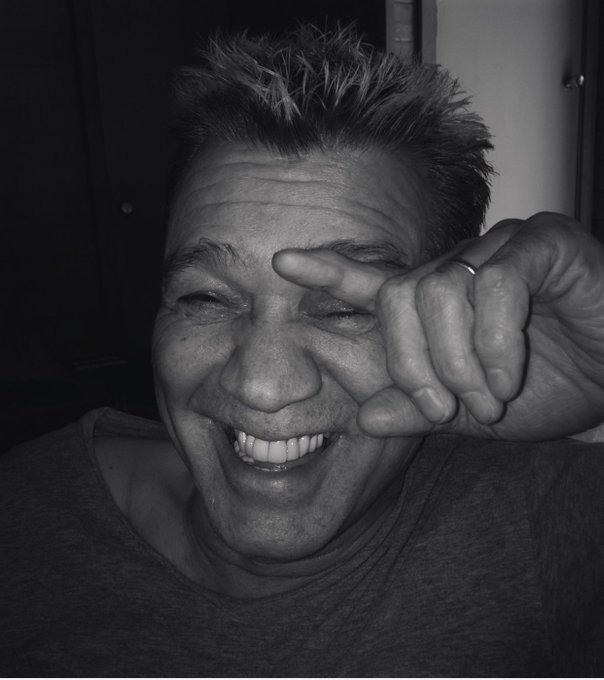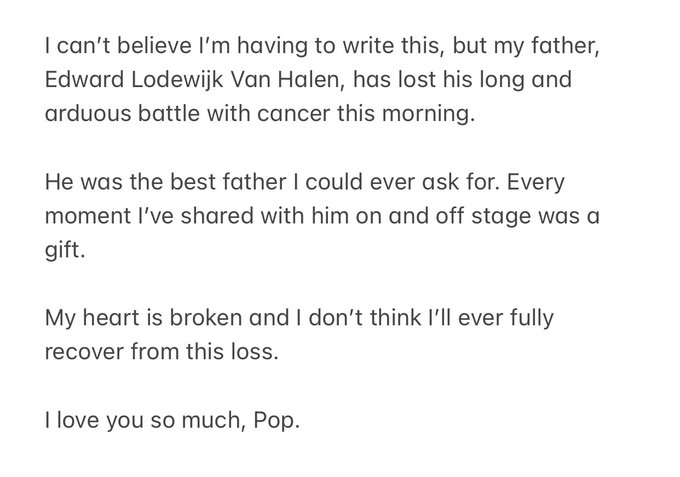Sources close to the guitarist have told the publication that Van Halen died at St. Johns Hospital in Santa Monica, CA, earlier today. His wife Janie was reportedly by his side at the time of his passing, along with the guitarist's son Wolfgang and brother/Van Halen drummer Alex.
Wolfgang confirmed his father's passing in a statement shared through Twitter. "He was the best father I could ever ask for. Every moment I've shared with him on and off stage was a gift," he wrote. "My heart is broken and I don't think I'll ever fully recover from this loss. I love you so much, Pop."
According to TMZ, Eddie Van Halen's battle against his disease took a sudden turn for the worse during the last 72 hours. Apparently, doctors had discovered his throat cancer had moved to his brain, as well as other internal organs. The artist had been battling his disease for over a decade, repeatedly going in and out of hospital over the years.
Edward Lodewijk Van Halen was born in Amsterdam in 1955, and moved with his family to Pasadena, CA, in 1962. As father Jan Van Halen was a clarinetist, saxophonist and pianist, both Eddie and Alex Van Halen would learn piano as children ahead of taking up their respective instruments in the years to come.
At first, it was Eddie who took to the drum kit, while Alex began playing guitar. However, upon hearing his older brother pound out the iconic drum solo from the Surfaris' "Wipeout," Eddie would pick up the six-string, idolizing guitarists including Eric Clapton and Led Zeppelin's Jimmy Page.
In a 1996 interview with Billy Corgan for Guitar World, Van Halen said that he "started smoking, drinking and playing the guitar at age 12," and shared a bit about the practice routine of his early years. "I used to sit on the edge of my bed with a six-pack of Schlitz Malt tails," Van Halen recalled. "My brother would go out at 7 p.m. to party and get laid, and when he'd come back at 3 a.m., I would still be sitting in the same place, playing guitar. I did that for years — I still do that."
As teenagers, Eddie and Alex would form a trio dubbed Mammoth, which also featured the guitarist on vocals. While playing "everywhere and anywhere, from backyard parties to places the size of...bathrooms," the brothers recruited vocalist David Lee Roth and bassist Michael Anthony from other area bands to form what would stand as Van Halen's first lineup.
The newly renamed Van Halen would continue to grow their audience by playing throughout Pasadena, with Eddie continuing to turn heads with his playing speed and innovative style that incorporated two-handed tapping, searing solos and feedback manipulation. Van Halen is now recognized for popularizing the technique, after being primarily inspired by Zeppelin's Page and Genesis' Steve Hackett.
In 1975, Van Halen would build his iconic "Frankenstrat" guitar, piecing together a slew of parts from a variety of instrument builders to create a six-string better suited to his playing style. Ten years after that, he successfully filed a patent for a "musical instrument support" system which would allow "total freedom of the player's hands to play the instrument in a completely new way...allowing the player to create new techniques and sounds previously unknown to any player."
In 1977, Mo Ostin and Ted Templeman of Warner Records would sign Van Halen to their first record deal after taking in a performance in Hollywood. The band would record material for what would become Van Halen later that year, and released the album in February, 1978.
"We didn't have a ton of material," bassist Anthony recalled in 2010. "So we basically just took our live show and all the songs we knew and went for it. The whole album only took a couple of weeks. Ted Templeman wanted to make a big, powerful guitar record, and he had all he needed in what Eddie was doing."
Van Halen features catalogue staples including "Runnin' With the Devil," "Ain't Talkin' 'Bout Love," "Jamie's Cryin'" and the band's cover of the Kinks' "You Really Got Me." Of course, Van Halen's six-string skill shines best on "Eruption," the instrumental that brought the guitarist's two-handed tapping technique to the modern rock world.
The band would begin work on material for 1979's Van Halen II less than a year after releasing their debut. Van Halen would continue to work at an album-a-year clip to release 1980's Women and Children First (the first of their studio efforts to feature all-original compositions), 1981's Fair Warning and 1982's Diver Down.
Throughout these years of sustained success, tension began to grow between Roth and Van Halen concerning the band's sonic direction, with the guitarist favouring more complex writing and arrangements in comparison to the vocalist's pop-leaning persuasions.
In 1983, Van Halen built his 5150 Studio in California, during which he began working with synthesizers. Ensuing album 1984 would split the difference between keyboard driven numbers such as "Jump" and "I'll Wait," and hard rock songs like "Panama" and "Hot for Teacher." With Van Halen's passing, 1984 now stands as the band's last album to feature all four original members, as Roth would soon leave the band after touring behind the release.
Van Halen would then fill the vacant vocalist position with Sammy Hagar, beginning their "Van Hagar" era with the arrival of 5150 in 1986. The band would then release OU812 (1988), For Unlawful Carnal Knowledge (1991) and Balance (1995) ahead of Hagar's departure in 1996. Van Halen III arrived in 1998, marking the band's only studio effort with Extreme vocalist Gary Cherone, and the last to feature bassist Anthony.
Van Halen would reunite with Roth on vocals for a North American tour in 2007, with a then-16-year-old Wolfgang Van Halen taking Anthony's place in the reformed lineup. This lineup would release the band's 12th and final studio LP, A Different Kind of Truth, which saw release in 2012.
Outside of his work with the band, Eddie Van Halen most famously recorded the guitar solo on Michael Jackson's Thriller standout "Beat It." Initially thinking he was being prank called upon being asked to record by Quincy Jones, he then hit the studio and recorded the dazzling passage free of charge. "I did it as a favour", he would later say. "I was a complete fool, according to the rest of the band, our manager and everyone else. I was not used. I knew what I was doing — I don't do something unless I want to do it."
Van Halen would also record with Queen guitarist Brian May, Nicolette Larson, Pink Floyd's Roger Waters, Steve Lukather, Black Sabbath's Tony Iommi and Geezer Butler, and LL Cool J.
Find tributes to Van Halen from family, friends and contemporaries below.
Tweet not found
The embedded tweet could not be found…
RIP Eddie Van Halen. Van Halen were a tremendous influence on both Vinnie & Dime & Pantera. Hopefully they are all rocking out together now!
My heart is broken. Eddie was not only a Guitar God, but a genuinely beautiful soul. Rest in peace, Eddie! ...Eddie Van Halen Dead at 65 from Cancer tmz.com/2020/10/06/edd…
I’m just devastated to hear the news of the passing of my dear friend Eddie Van Halen. He fought a long and hard battle with his cancer right to the very end. Eddie was one of a very special kind of person, a really great friend. Rest In Peace my dear friend till we meet again.
Tweet not found
The embedded tweet could not be found…
Just when I thought 2020 couldn't get any worse, I hear Eddie Van Halen has passed. So shocking- One of the nicest, down to Earth men I have ever met and toured with. A true gent and true genius. RIP. So sad.Thoughts go out to his brother Alex, and his family.
Just heard the news of Eddie Van Halen’s passing ..... this hit me hard.
Rest in peace guitar legend Eddie Van Halen. 💔 We will miss you. #fuckcancer @eddievanhalen #eddievanhalen
Oh NO! Speechless. A trailblazer and someone who always gave everything to his music. A good soul. I remember first seeing him playing at the Starwood in 1976 and he WAS Eddie Van Halen. So shocked and sad. My condolences to Wolfie and the family.
I am devastated at the news of the passing of my friend Eddie Van Halen.
youtube.com/watch?v=BR4S1F… Apex talent. An unparalleled titan in the annals of rock n roll. One of the greatest musicians in the history of mankind. Rest In Peace, King Edward
Very sad to hear about the passing of the legendary @eddievanhalen. You will be missed. #RIPEddieVanHalen 📸: @markweissguy #EddieVanHalen @VanHalen
Sad to hear Eddie Van Halen has passed away. A guitar innovator with a fierce spirit of musical and technical exploration. Prayers and thoughts with his family and friends.
#RIP to a legend, Eddie Van Halen. So sad!
The world lost an icon, innovator, showman, virtuoso, master songwriter and perhaps one of the biggest inspirations ever to learn how to play guitar. Heartbroken to hear of Eddie Van Halen’s passing. Our love, condolences and best wishes to his his family, friends and fans. #RIP
He was immortal even while he was alive. The name Eddie Van Halen has always been synonymous with insane ability. No matter what kind of style you play, no one can deny his colossal influence. To have a sound not only uniquely signature to the artist, but of an entire era. 🤘🎸⚡️
Rest In Peace to one of the truly greatest musicians of all time. My first guitar hero - the guitarist I grew up listening to in car rides with my family - a man I excitedly share the same birth date and month with: Mr. Eddie Van Halen.

























